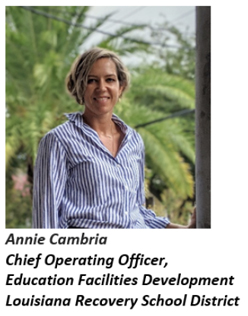
They say the last 10% of anything is the hardest part to get done. Those last 5 pounds, that last mile of the race, the last few schools of a city altering $2 Billion School Rebuilding Program. The national and local focus may have shifted to other priorities, but for those children waiting for their new school, the School Facility Master Plan is still priority #1. In this vein, the team working to complete the School Facilities Master Plan continues to wear their “Finish Strong” shirts. Many members have been working on this program since the days of clearing muck out of damaged schools. These men and women have quite literally dedicated their careers and their lives to making sure that every child in New Orleans has the opportunity to excel in a 21st Century School building. Striving to make sure we have built an equitable system that doesn’t build different schools for black children versus white children or for boys versus girls.
We have learned a lot along the way. Other state and city agencies now lean on the expertise of the School Facilities Master Plan team, developed by forging the way through unchartered waters to make the program the best it could be. We were the first state agency to utilize Construction Management at Risk successfully, with 3 schools completed to date with this method and 3 more in the pipeline; the only state agency to implement a successful and rigorous Disadvantaged Business Enterprise Program where we have surpassed our 25% goals; and the first and only to leverage our FEMA dollars with innovative financial structuring with historic and New Markets tax credits raising over $80 million in additional equity – the cost of nearly 3 more full school buildings.
Luckily, given the expertise in spending almost $2 billion on school projects, we have developed strong standard operating procures (SOP) and have intimate knowledge of best practices in school building. These have been our guiding light to make sure the last projects get built as the dollars get tighter and tighter. Then the global pandemic hit. Like everyone else in the world, we had to rethink everything – from how to handle in-person drop offs of bid packages during the height of uncertainity and COVID cases in Louisiana to rethinking internet hotspots at schools to have more placed outside for students social distancing and neighbors who might need internet access.
As we wrap up this unprecedented program during these uncertain times, our schools are trying to figure out how to welcome students back safely in the COVID-19 era. Our buildings were not built with social distancing in mind. Many of our historic structures have individual classroom VRF units that circulate the air in only that classroom which helps minimize viral spread in a building but this is a lucky coincidence not an intentional outcome of the building program. Our libraries, cafeterias and auditoriums will need to be utilized differently or remain unused. It will take innovation from our charter leaders and NOLA-PS to keep students and teachers safe. Already long drop off lines will need to be reconfigured to insure that the adding of health screening doesn’t disrupt neighborhoods further. Certainly the reopening of schools safely must be a top priority to any economic return to normalcy. The inability to focus on containment in the best interest of our children has been a problem across country. But it is not too late yet and we must all alter our own SOP to make sure that all children can return safely and continue to learn.
While leading this program over the past few years, the biggest challenge seemed to be how to wind it down while still delivering high quality schools on time and on budget. Unexpected challenges have arisen, which have forced us to find solutions with dwindling resources. The team has stepped up to the challenge, continuing to pursue all projects’ completion. It is a continuation of the backbone of this program which lies in its innovation and flexibility, which started in creating the new paradigm for FEMA to react to large scale disasters to now having to rewrite all the rules during COVID-19 pandemic.
